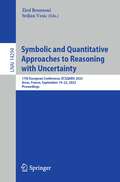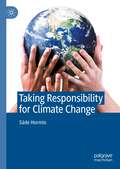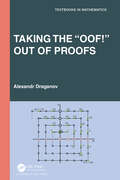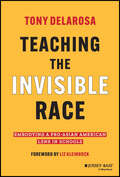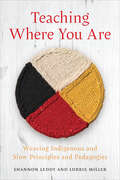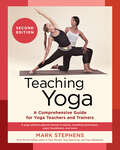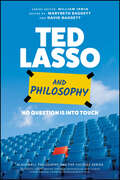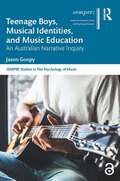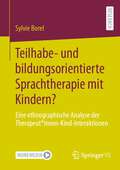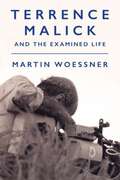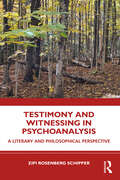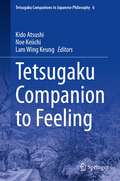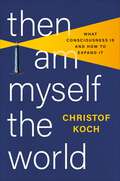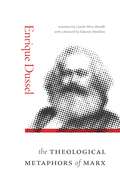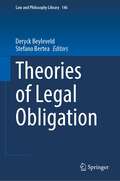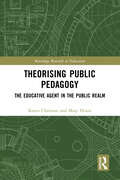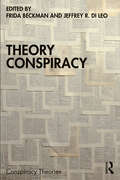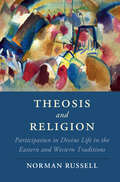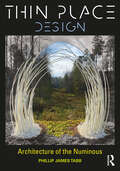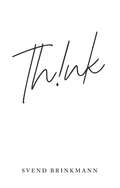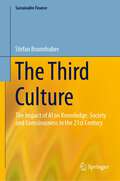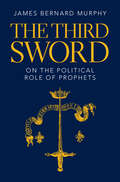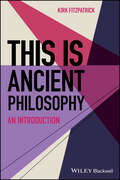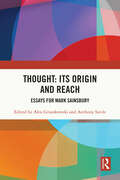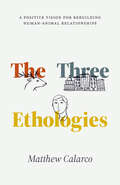- Table View
- List View
Symbolic and Quantitative Approaches to Reasoning with Uncertainty: 17th European Conference, ECSQARU 2023, Arras, France, September 19–22, 2023, Proceedings (Lecture Notes in Computer Science #14294)
by Zied Bouraoui Srdjan VesicThis book constitutes the refereed proceedings of the 17th European Conference on Symbolic and Quantitative Approaches to Reasoning with Uncertainty, ECSQARU 2023, held in Arras, France, in September 2023. The 35 full papers presented in this volume were carefully reviewed and selected from 46 submissions. The papers are organized in topical sections about Complexity and Database Theory; Formal Concept Analysis: Theoretical Advances; Formal Concept Analysis: Applications; Modelling and Explanation; Semantic Web and Graphs; Posters.
Taking Responsibility for Climate Change
by Säde HormioThis book proposes that it is not only states and international bodies that have a responsibility to take action toward mitigating climate change. Other collective agents, such as corporations, need to also come onboard. Additionally, the book argues that climate change is not solely a problem for collective agents, but also for individuals, as they are members of collectives and groups of several kinds. Therefore, framing climate change responsibility exclusively from either the collective or the individual perspective leaves out something crucial: how we all are influenced by the collectives we belong to and how, in turn, collectives are influenced by individuals. The focus of the book is on areas of climate change responsibility that are often left out of the picture or get too little attention in climate ethics, such as carbon inequality within countries. But why should any theoretical arguments about normative issues matter when we have a real-life climate crisis on our hands? Säde Hormio argues that ethical arguments have an important role in setting climate policy: they can highlight what values are at stake and help ground normative arguments in public deliberations.
Taking the “Oof!” Out of Proofs (Textbooks in Mathematics)
by Alexandr DraganovThis book introduces readers to the art of doing mathematical proofs. Proofs are the glue that holds mathematics together. They make connections between math concepts and show why things work the way they do. This book teaches the art of proofs using familiar high-school concepts, such as numbers, polynomials, functions, and trigonometry. It retells math as a story, where the next chapter follows from the previous one.Readers will see how various mathematical concepts are tied and will see that mathematics is not a pile of formulas and facts; rather, it has an orderly and beautiful edifice.The author begins with basic rules of logic and then progresses through the topics already familiar to the students: numbers, inequalities, functions, polynomials, exponents, and trigonometric functions. There are also beautiful proofs for conic sections, sequences, and Fibonacci numbers. Each chapter has exercises for the reader.Reviewer Comments:I find the book very impressive. The choice and sequence of topics is excellent, and it is wonderful to have all of these things together in one volume. Theorems are clearly stated, and proofs are accurate. – Michael ComenetzThe thoroughness of the narrative is one of the main strengths of the book. The book provides a perfect illustration of mathematical thinking. Each step of a given derivation is precise and clear. – Julie GershunskayaDraganov’s book stands out from the many competing books. Draganov’s goal is to show that mathematics depends on the notion of proof. Unlike other transition books, he addresses mathematical topics at an accessible level, rather than topics studied later in the university curriculum. – Ken Rosen
Teaching the Invisible Race: Embodying a Pro-Asian American Lens in Schools
by Tony DelaRosaTransform How You Teach Asian American Narratives in your Schools! In Teaching the Invisible Race, anti-bias and anti-racist educator and researcher Tony DelaRosa (he, siya) delivers an insightful and hands-on treatment of how to embody a pro-Asian American lens in your classroom while combating anti-Asian hate in your school. The author offers stories, case studies, research, and frameworks that will help you build the knowledge, mindset, and skills you need to teach Asian-American history and stories in your curriculum. You’ll learn to embrace Asian American joy and a pro-Asian American lens—as opposed to a deficit lens—that is inclusive of Brown and Southeast Asian American perspectives and disability narratives. You’ll also find: Self-interrogation exercises regarding major Asian American concepts and social movements Ways to center Asian Americans in your classroom and your school Information about how white supremacy and anti-Blackness manifest in relation to Asian America, both internally and externallyAn essential resource for educators, school administrators, and K-12 school leaders, Teaching the Invisible Race will also earn a place in the hands of parents, families, and community members with an interest in advancing social justice in the Asian American context.
Teaching Where You Are: Weaving Indigenous and Slow Principles and Pedagogies
by Shannon Leddy Lorrie MillerTeaching Where You Are offers a guide for non-Indigenous educators to work in good ways with Indigenous students and provides resources across curricular areas to support all students. In this book, two seasoned educators, one Indigenous and one settler, bring to bear their years of experience teaching in elementary, secondary, and post-secondary contexts to explore the ways in which Indigenous and Slow approaches to teaching and learning mirror and complement one another. Using the holistic framework of the Medicine Wheel, Shannon Leddy and Lorrie Miller illustrate the ways in which interdisciplinary thinking, a focus on experiential learning, and the thoughtful application of the 4Rs – Respect, Relevance, Reciprocity, and Responsibility – can bring us back to the principle of teaching people, not subjects. Bringing forth the ways in which colonialism and cognitive imperialism have shaped Canadian curriculum and consciousness, the book offers avenues for the development of decolonial literacy to support the work of Indigenizing education. In considering the importance of engaging in decolonizing and Indigenizing approaches to education through Slow and Indigenous pedagogies using the lens of place-based and land-based education, Teaching Where You Are presents a text useful for teachers and educators grappling with the ongoing impacts of colonialism and the soul-work of how to decolonize and rehumanize education in meaningful ways.
Teaching Yoga, Second Edition: A Comprehensive Guide for Yoga Teachers and Trainers: A Yoga Alliance-Aligned Manual of Asanas, Breathing Techniques, Yogic Foundations, and More
by Mark StephensThe bestselling guide for yoga teachers and trainers, revised and updated—a comprehensive Yoga Alliance-aligned manual of asanas, breathing techniques, yogic foundations, and more.Revised and updated, Teaching Yoga by yoga expert Mark Stephens is one of the most popular resources for new and experienced teachers, and has been a trusted guide since its publication in 2010.This classic resource covers fundamental topics of yoga history and philosophy, as well as each of the 11 major styles of contemporary yoga. There is also practical advice for every stage of the teaching process, including tools for teaching 108 yoga poses (asanas), breathing techniques (pranayama), and meditation.The 2nd edition—adapted to meet the needs of the modern yoga teacher—features:Updated sections on yoga history and philosophyDiscussions of trauma-sensitive yogaCoverage of cultural appropriation, racism, and sexism in yoga An inclusive approach that expands beyond the traditional vinyasa flow styleNew photos and illustrations1-page summaries after each chapterAn extended list of references for further learningDeveloped to meet 100% of the teacher training curriculum standards set by Yoga Alliance, the world&’s leading registry and accreditation source for yoga teachers and schools, Teaching Yoga is ideal for use as a core textbook in yoga teacher training programs.
Ted Lasso and Philosophy: No Question Is Into Touch (The Blackwell Philosophy and Pop Culture Series)
by William IrwinAn accessible and engaging journey through the philosophical themes and concepts of Ted Lasso Ted Lasso and Philosophy explores the hidden depths beneath the vibrant veneer of AppleTV’s breakout, award-winning sitcom. Blending philosophical sophistication with winsome appreciation of this feel-good comedy, the collection features 20 original essays canvassing the breadth of the series and carefully considering the ideas it presents, including the goal of competition, the role of mental health, sportsmanship, revenge versus justice, the importance of friendship, the imperative of respect for persons, humility, leadership, identity, character growth, courage, journalistic ethics, belief, forgiveness, what love looks like, and just how evil tea is. In a nod to the show’s many literary allusions, the compilation concludes with a whimsical appendix that catalogs the books most significant to Ted Lasso’s themes and characters. If football is life, as Dani Rojas fondly repeats, then this book’s a fitting primer. Covers the full breadth of the original Ted Lasso series, including the third season Explores every major character and all of the show's significant subplots and elements Written in the spirit of the show, with in-jokes that will appeal to Ted Lasso fans Features an introduction that guides readers through the book’s materials Includes Beard's Bookshelf, a bibliography of the most significant books shown or alluded to in the series Ted Lasso and Philosophy is for the curious, not judgmental. Sport is quite the metaphor, and we can’t wait to unpack it with you.
Teenage Boys, Musical Identities, and Music Education: An Australian Narrative Inquiry (ISSN)
by Jason GoopyMusic is a powerful process and resource that can shape and support who we are and wish to be. The interaction between musical identities and learning music highlights school music education’s potential contributions and responsibilities, especially in supporting young people’s mental health and well-being. Through the distinctive stories and drawings of Aaron, Blake, Conor, Elijah, Michael, and Tyler, this book reveals the musical identities of teenage boys in their final year of study at an Australian boys’ school.This text serves as an interface between music, education, and psychology using narrative inquiry. Previous research in music education often seeks to generalise boys, whereas this study recognises and celebrates the diverse individual voices of students where music plays a significant role in their lives. Adolescent boys’ musical identities are examined using the theories of identity work and possible selves, and their underlying music values and uses are considered important guiding principles and motivating goals in their identity construction. A teaching and learning framework to shape and support multiple musical identities in senior secondary class music is presented.The relatable and personal stories in this book will appeal to a broad readership, including music teachers, teacher educators, researchers, and readers interested in the role of music in our lives. Creative and arts-based research methods, including narrative inquiry and innovative draw and tell interviews, will be particularly relevant for research method courses and postgraduate research students.
Teilhabe- und bildungsorientierte Sprachtherapie mit Kindern?: Eine ethnographische Analyse der Therapeut*innen-Kind-Interaktionen
by Sylvie BorelAusgehend von der theoretischen Grundannahme, dass Sprachtherapie als Bestandteil von Bildung anzusehen ist, werden Interaktionen zwischen Sprachtherapeut*innen und Kindern im vorschulischen Bereich über einen ethnographischen Zugang untersucht. Die zentrale Frage der Arbeit lautet, inwieweit Kindern in diesem frühkindlichen Bildungskontext Teilhabe ermöglicht wird. Die Autorin kommt zu dem Ergebnis, dass die Praktiken der Sprachtherapie von einer starken Machtasymmetrie gekennzeichnet sind, die die Sprachprofessionellen in Form von fortlaufenden Evaluationen und dem Einfordern von formal festgelegten monolingualen Kurzantworten aufrechterhalten. Dadurch kommt es zu Beschränkungen von mehrsprachig-kommunikativer Teilhabe und weiterer Beteiligungsmöglichkeiten der als ‚sprachbeeinträchtigt‘ adressierten Kinder.
Terrence Malick and the Examined Life (Intellectual History of the Modern Age)
by Martin WoessnerTerrence Malick is one of American cinema’s most celebrated filmmakers. His films—from Badlands (1973) and Days of Heaven (1978) to The Thin Red Line (1998), The Tree of Life (2011), and, most recently, A Hidden Life (2019)—have been heralded for their artistry and lauded for their beauty, but what really sets them apart is their ideas. Terrence Malick and the Examined Life is the most comprehensive account to date of this unparalleled filmmaker’s intellectual and artistic development.Utilizing newly available archival sources to offer original interpretations of his canonical films, Martin Woessner illuminates Malick’s early education in philosophy at Harvard and Oxford as well as his cinematic apprenticeship at the American Film Institute to show how a young student searching for personal meaning became a famous director of Hollywood films. Woessner’s book presents a rich, interdisciplinary exploration of the many texts, thinkers, and traditions that made this transformation possible—from the novels of Hamlin Garland, James Jones, and Walker Percy to the philosophies of Stanley Cavell, Martin Heidegger, and Søren Kierkegaard to road movies, Hollywood Westerns, and the comedies of Jean Renoir. Situating Malick’s filmmaking within recent intellectual and cultural history, Woessner highlights its lasting contributions to both American cinema and the life of the mind.Terrence Malick and the Examined Life suggests it is time for philosophy to be viewed not merely as an academic subject, overseen by experts, but also as a way of life, open to each and every moviegoer.
Testimony and Witnessing in Psychoanalysis: A Literary and Philosophical Perspective
by Zipi Rosenberg SchipperIn this fascinating volume, Zipi Rosenberg Schipper approaches the fundamental topic of testimony, seeking to recognize its value as a distinct and vital function in psychoanalytic work, separate from its inherited importance to work on trauma. Rosenberg Schipper introduces a revivifying philosophical, linguistic and psychoanalytic approach to the act of testimony, focusing on the role of witnessing in daily life and the importance it has as a therapeutic tool in psychoanalytic and psychological therapy. Throughout, she pinpoints three key psychoanalytic theories on patient testimony. She begins by looking at Freud’s foundational work on testimony as a means of concealing the unconscious and the questions of credibility in the consulting room this creates before looking at Winnicottian and Kohutian theories, whereby therapists take everything the patient says as a definitive truth. She concludes by looking at the Intersubjective and Relational schools of thought, where the therapist assumes the role of witness. By providing a comprehensive overview of the conflicting theories on the topic, Rosenberg Schipper equips practicing psychoanalysts and analysts-in-training with the tools necessary to utilize this vital therapeutic device and engage with it in treatment for all patients.
Tetsugaku Companion to Feeling (Tetsugaku Companions to Japanese Philosophy #6)
by Kido Atsushi Noe Keiichi Lam Wing KeungThis edited volume is the first in English that covers the philosophy of feeling and related topics in Japanese philosophy on Nishida Kitarō and fellow thinkers. Part I focuses on Nishida Kitarō’s philosophy of feeling, including, but not limited to, comparisons with Tanabe Hajime, Koyama Iwao, and provides coverage of Buddhist, moral and Chinese philosophy. Part II goes beyond Kitarō into topics such as Japanese aesthetics, Nietsche’s reception in Japan, and the philosophy of AI. This is a comprehensive scholarly text on feeling in Japanese philosophy, aimed at researchers and students working in the field.
Then I Am Myself the World: What Consciousness Is and How to Expand It
by Christof Koch"Deeply personal and infinitely digestible, Then I Am Myself the World is a remarkable must-read for anyone interested in knowing their mind.&”―Judson Brewer MD, PhD, New York Times–bestselling author of Unwinding Anxiety The world&’s leading investigator of consciousness argues that by understanding what consciousness does—cause change in the world—we can understand its origins and its future In Then I Am Myself the World, Christof Koch explores the only thing we directly experience: consciousness. At the book&’s heart is integrated-information theory, the idea that the essence of consciousness is the ability to exert causal power over itself, to be an agent of change. Koch investigates the physical origins of consciousness in the brain and how this knowledge can be used to measure consciousness in natural and artificial systems. Enabled by such tools, Koch reveals when and where consciousness exists, and uses that knowledge to confront major social and scientific questions: When does a fetus first become self-aware? Can psychedelic and mystical experiences transform lives? What happens to consciousness in near-death experiences? Why will generative AI ultimately be able to do the very thing we can do, yet never feel any of it? And do our experiences reveal a single, objective reality? This is an essential book for anyone who seeks to understand ourselves and the future we are creating.
The Theological Metaphors of Marx
by Enrique DusselIn The Theological Metaphors of Marx, Enrique Dussel provides a groundbreaking combination of Marxology, theology, and ethical theory. Dussel shows that Marx unveils the theology of capitalism in his critique of commodity fetishization. Capitalism constitutes an idolatry of the commodity that undergirds the capitalist expropriation of labor. Dussel examines Marx’s early writings on religion and fetishism and proceeds through what Dussel refers to as the four major drafts of Capital, ultimately situating Marx’s philosophical, economic, ethical, and historical insights in relation to the theological problems of his time. Dussel notes a shift in Marx’s underlying theological schema from a political critique of the state to an economic critique of the commodity fetish as the Devil, or anti-God, of modernity. Marx’s thought, impact, and influence cannot be fully understood without Dussel’s historic reinterpretation of the theological origins and implications of Marx’s critiques of political economy and politics.
Theories of Legal Obligation (Law and Philosophy Library #146)
by Deryck Beyleveld Stefano BerteaThis volume collects six original essays by internationally respected researchers who have devoted themselves to the study of legal obligation. It brings together works that innovatively address key dimensions of the current debates concerning legal obligation from different and, in some cases, even opposing theoretical perspectives. As a result, the collection offers a comprehensive discussion of legal obligation that promises to significantly advance our understanding of the obligatory dimension of law. What specifically connects the contributions gathered here is one common thread: coming to terms with a notion – legal obligation – that is of both practical and theoretical importance. On the one hand, it is widely regarded as a fundamental legal concept by legal practitioners and laypeople alike, as not only judges, prosecutors, lawyers, and juries but also ordinary citizens make extensive use of obligation-related terms and discourses. On the other hand, the notion of legal obligation is of paramount significance for the theory of law. Indeed, even legal theorists who, quite understandably, refuse to reduce the law to a mere obligation-imposing device and opt instead for a view in which the normative dimension of the law also encompasses powers, rights, permissions, privileges and immunities, duly acknowledge the centrality of legal obligation for the understanding and conceptualisation of law. Hence the importance of the treatments presented in this volume.
Theorising Public Pedagogy: The Educative Agent in the Public Realm (Routledge Research in Education)
by Karen Charman Mary DixonDrawing on the ideas of Hannah Arendt and Michel Foucault, this book extends the theoretical understanding of public pedagogy and brings into sharp focus the elements that constitute the public realm; the site of public pedagogy. Karen Charman and Mary Dixon offer a new theorisation of the public, a term at the heart of debate in the field, heightened in this post-truth era by the COVID-19 pandemic, the rise of fake news and the technological reconfigurations of public life. The new theorization addresses the ‘public’, ‘pedagogy’ and their confluence in ‘public pedagogy’. The book explores a deep engagement with the architecture and dynamics of pedagogy and argues for the positioning of pedagogy with the public. The authors contribute to a theorisation that re-considers the individual and their capacity for agency within the public realm. The book presents knowledge and pedagogical encounters as key elements of public pedagogy and most significantly, the educative agent as a means of critically rethinking social life and learning in public spaces. Presenting an innovative theoretical approach, this book will be of interest to academics in the fields of public and critical pedagogy and postgraduate students in education, cultural studies and politics.
Theory Conspiracy (Conspiracy Theories)
by Frida Beckman Di Leo, Jeffrey R.Theory Conspiracy provides a state-of-the-art collection that takes stage on the meeting and/or battlegrounds between conspiracy theory and theory-asconspiracy. By deliberately scrambling the syntax—conspiracy theory cum theory conspiracy—it seeks to open a set of reflections on the articulation between theory and conspiracy that addresses how conspiracy might rattle the sense of theory as such. In this sense, the volume also inevitably stumbles on the recent debates on postcritique. The suspicion that our ways of reading in the humanities have been far too suspicious, if not paranoid, has gained considerable attention in a humanities continuously questioned as superfluous at best and leftist and dangerous at worst. The chapters in this volume all approach this problematic from different angles. It features clear engaging writing by a set of contributors who have published extensively on questions of paranoia, conspiracy theory, and/or the state of theory today. This collection will appeal to readers interested in conspiracy theories, critical theory, and the future of humanities.
Theosis and Religion: Participation in Divine Life in the Eastern and Western Traditions (Cambridge Studies in Religion, Philosophy, and Society)
by null Norman RussellTheosis, originally a Greek term for Christian divinisation or deification, has become a vogue word in modern theology. Although recent publications have explored its meaning in a selection of different contexts, this is the first book to offer a coherent narrative of how the concept of theosis developed in both its Eastern and Western versions. Norman Russell shows how the role of Dionysius the Areopagite was pivotal, not only in Byzantium but also in the late mediaeval West, where it strengthened the turn towards an individualistic interiority. Russell also relates theosis to changing concepts of religion in the modern age. He investigates the Russian version of theosis, introduced in the West by Russian members the Paris School after the 1917 Revolution. Since then, theosis has undergone additional development through the addition of esoteric elements which have since passed into the mainstream of all theological traditions and even into popular spirituality.
Thin Place Design: Architecture of the Numinous
by Phillip James TabbWhat makes the places we inhabit extraordinary? Why are some urban spaces more vital and restorative? Wonderful landscapes, inspiring works of architecture and urban design, and the numinous experiences that accompany them have been an integral dimension of our culture. Up-lifting spaces, dramatic use of natural light, harmonic proportional geometry, magical landscapes, historic sites and vital city centers create special, even sacred moments in architecture and planning. This quality of experience is often seen as an aesthetic purpose intended to inspire, ennoble, ensoul and spiritually renew. Architecture and urban spaces, functioning in this way, are considered to be thin places.
Think: In Defence of a Thoughtful Life
by Svend BrinkmannA defining feature of being human is our ability to think. We refer to ourselves, after all, as Homo sapiens. But in a world where experiencing and achieving as much as possible is the number one preoccupation, there is little room for reflection. Technology is also making everything easier, eroding the need for us to think at all. Of course deep, critical thinking can be difficult, sometimes painful, and it takes time. But it is fundamental to our well-being. In this new book, bestselling philosopher and psychologist Svend Brinkmann argues for a return to the thoughtful life, where we learn to think well, to think deeply, to lose ourselves in reverie and tune in to our inner voice. By spending time in our thoughts and letting them wander freely, we will discover that thinking is one of the most enriching things we can do in life – and one of the most human, too.
The Third Culture: The Impact of AI on Knowledge, Society and Consciousness in the 21st Century (Sustainable Finance)
by Stefan BrunnhuberWe are currently witnessing the emergence of a ‘third culture’, driven by unprecedented developments that are changing the playing field. These include advances in AI, big data analysis and robotics. The traditional ‘two cultures’ view (S. P. Snow) distinguishes between the sciences and the humanities. The wisdoms these two cultures offer are separated from each other, with little to no interaction or mutual comprehension. However, over the past two decades, and for the first time in human history, a new, third culture has appeared. This new culture, rooted in new technologies, not only pursues its own form of rationality but also supports advances in the original two cultures, deepening and expanding our individual and collective consciousness so that we can see more and do better. It will eventually give rise to new forms of consciousness based not on biochemical signals, but on copper wires and lithium chips. These new machine intelligences will change the world and force us to realise: we are no longer alone. The human species’ position in the twenty-first century will be fundamentally redefined: not as a conductor leading the orchestra, but a single string player within it.
This is Ancient Philosophy: An Introduction (This is Philosophy)
by Kirk FitzpatrickTHIS IS ANCIENT PHILOSOPHY “A masterful introduction to ancient philosophy. Fitzpatrick knows the contemporary scholarship on these authors, so he can shift from summarizing their thought to scrutinizing individual arguments. Meanwhile the writing remains so accessible that a reader might not notice how much he covers. The prose is precise but relaxed, with details that enrich the texture: the Pythagoreans’ harmonies, the Stoic Horned Argument, Antisthenes’ daily walk to Socrates. Students and instructors alike will benefit.” —Nickolas Pappas, Professor at City College of New York (CUNY) This Is Ancient Philosophy is a fascinating introduction to the major philosophers and foundational concepts of classical antiquity. Assuming no prior knowledge, the book uses an intuitive, readable narrative style as it examines the ideas, influences, and interconnections of philosophers such as Socrates, the Sophists, Plato, and Aristotle, as well as philosophical schools of thought including Cynicism, Epicureanism, Stoicism, and Skepticism. Divided into three parts, the book opens with an overview of early Greek philosophy, describing the turn from mythological thinking to philosophical analysis. The second part focuses on the distinctions between the subjects of philosophy in both the Golden Age and today, followed by a survey of the Hellenistic period and a discussion of the relation between fate and freedom of action. Throughout, readers are aided by a wealth of instructive and engaging charts, grids, figures, and a detailed map illustrating the chronological development of philosophy, from Asia Minor to southern Italy and Athens. Part of the popular This Is Philosophy series, This Is Ancient Philosophy is an excellent text for students of philosophy, both introductory and advanced, and general readers with interest in the philosophy of the classical era.
Thought: Essays for Mark Sainsbury
by Alex Grzankowski Anthony SavileThe work of Mark Sainsbury has made a significant and challenging contribution to several central areas of philosophy, especially philosophy of language and logic. He has made significant contributions to puzzles concerning the nature of thought and language and pioneered research in the philosophical theory known as fictionalism.In this outstanding volume, 20 contributors engage with Sainsbury’s work but also go beyond it, exploring fundamental problems in the philosophy of language, mind, and logic. Topics covered include propositional thought, intentionality, the mind-body problem, singular thoughts, the individuation of concepts, nominalisation, logical form, non-existent objects, and vagueness.Thought: Its Origin and Reach will be of interest to professional philosophers and students working in philosophy of mind, language, epistemology, and metaphysics.
The Three Ethologies: A Positive Vision for Rebuilding Human-Animal Relationships (Animal Lives)
by Matthew CalarcoA transformative vision for human-animal relations on personal, social, and environmental levels. The Three Ethologies offers a fresh, affirmative vision for rebuilding human-animal relations. Venturing beyond the usual scholarly and activist emphasis on restricting harm, Matthew Calarco develops a new philosophy for understanding animal behavior—a practice known as ethology—through three distinct but interrelated lenses: mental ethology, which rebuilds individual subjectivity; social ethology, which rethinks our communal relations; and environmental ethology, which reconfigures our relationship to the land we co-inhabit with our animal kin. Drawing on developments in philosophy, (eco)feminist theory, critical geography, Indigenous studies, and the environmental humanities, Calarco casts an inspiring vision of how ethological living can help us to reimagine our ideas about goodness, truth, and beauty.
